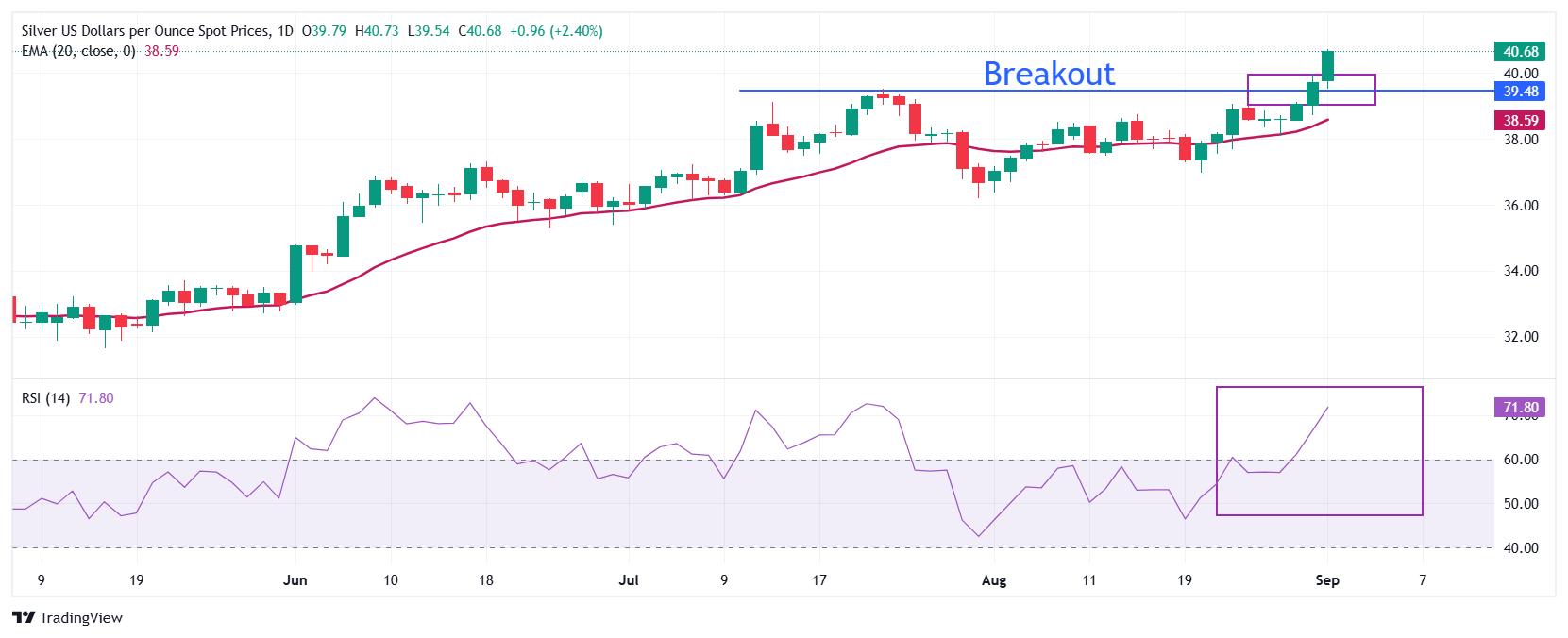Silver Price Forecast: XAG/USD surges above $40 as Fed seems to cut interest rates in September
- Silver price jumps to near $40.70 as the Fed is expected to cut interest rates in the policy meeting this month.
- Fed Daly expects that the tariff-driven inflation will prove to be one-time.
- The US appeals court has called US President Trump’s tariffs as “illegal”.
Silver price (XAG/USD) posts a fresh 14-year high around $40.70 during the European trading session on Monday. The white metal strengthens as traders are confident that the Federal Reserve (Fed) will cut interest rates in the policy meeting in September.
According to the CME FedWatch tool, there is an 87.6% chance that the Fed will cut interest rates in the policy meeting this month.
Theoretically, lower interest rates by the Fed bode well for non-yielding assets, such as Silver.
On Friday, San Francisco Fed President Mary Daly signaled that officials will reduce interest rates in the policy meeting this month, citing escalated labor market risks. Daly also stated that the tariff-driven inflation will likely be temporary.
“Tariffs are pushing inflation higher and the labor market is slowing, Daly said and added, “I think tariff-related price increases will be a one-off.”
Meanwhile, weakness in the US Dollar (USD) due to growing concerns over the credibility of the US economic policies has also contributed to strength in the Silver. During the press time, the US Dollar Index (DXY), which tracks the Greenback’s value against six major currencies, trades 0.2% lower near the monthly low around 97.60.
A panel of judges stated on Friday that US President Trump has exceeded his authority to fulfil his tariff agenda, citing them as “illegal” and accused him for wrongfully invoking emergency law.
Silver technical analysis
Silver price jumps to near $40.70 after a breakout above the previous high of $39.53 recorded on July 23. The near-term trend of the Silver price is bullish as the 20-day Exponential Moving Average (EMA) slopes higher around $38.60.
The 14-day Relative Strength Index (RSI) jumps to near 70.00, suggesting that a fresh bullish momentum has been triggered.
Looking down, the July 23 high around $39.53 will act as key support for the major. On the upside, the pair has entered an uncharted territory and could extend its upside to the August 2011 high around $44.24.
Silver daily chart

Silver FAQs
Silver is a precious metal highly traded among investors. It has been historically used as a store of value and a medium of exchange. Although less popular than Gold, traders may turn to Silver to diversify their investment portfolio, for its intrinsic value or as a potential hedge during high-inflation periods. Investors can buy physical Silver, in coins or in bars, or trade it through vehicles such as Exchange Traded Funds, which track its price on international markets.
Silver prices can move due to a wide range of factors. Geopolitical instability or fears of a deep recession can make Silver price escalate due to its safe-haven status, although to a lesser extent than Gold's. As a yieldless asset, Silver tends to rise with lower interest rates. Its moves also depend on how the US Dollar (USD) behaves as the asset is priced in dollars (XAG/USD). A strong Dollar tends to keep the price of Silver at bay, whereas a weaker Dollar is likely to propel prices up. Other factors such as investment demand, mining supply – Silver is much more abundant than Gold – and recycling rates can also affect prices.
Silver is widely used in industry, particularly in sectors such as electronics or solar energy, as it has one of the highest electric conductivity of all metals – more than Copper and Gold. A surge in demand can increase prices, while a decline tends to lower them. Dynamics in the US, Chinese and Indian economies can also contribute to price swings: for the US and particularly China, their big industrial sectors use Silver in various processes; in India, consumers’ demand for the precious metal for jewellery also plays a key role in setting prices.
Silver prices tend to follow Gold's moves. When Gold prices rise, Silver typically follows suit, as their status as safe-haven assets is similar. The Gold/Silver ratio, which shows the number of ounces of Silver needed to equal the value of one ounce of Gold, may help to determine the relative valuation between both metals. Some investors may consider a high ratio as an indicator that Silver is undervalued, or Gold is overvalued. On the contrary, a low ratio might suggest that Gold is undervalued relative to Silver.

